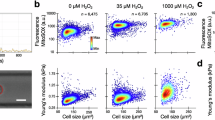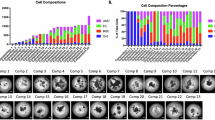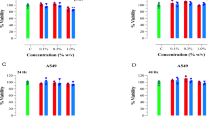Summary
The present study examined the ability of human monocytes to produce reactive oxygen intermediates after a contact with tumour cells. Monocytes generated oxygen radicals, as measured by luminol-enhanced chemiluminescence and superoxide anion production, after stimulation with the tumour, but not with untransformed, cells. The use of specific oxygen radical scavengers and inhibitors, superoxide dismutase, catalase, dimethyl sulphoxide and deferoxamine as well as the myeloperoxidase inhibitor 4-aminobenzoic acid hydrazide, indicated that chemiluminescence was dependent on the production of superoxide anion and hydroxyl radical and the presence of myeloperoxidase. The tumour cell-induced chemiluminescent response of monocytes showed different kinetics from that seen after activation of monocytes with phorbol ester. These results indicate that human monocytes can be directly stimulated by tumour cells for reactive oxygen intermediate production. Spontaneous monocyte-mediated cytotoxicity towards cancer cells was inhibited by superoxide dismutase, catalase, deferoxamine and hydrazide, implicating the role of superoxide anion, hydrogen peroxide, hydroxyl radical and hypohalite. We wish to suggest that so-called ‘spontaneous’ tumoricidal capacity of freshly isolated human monocytes may in fact be an inducible event associated with generation of reactive oxygen intermediates and perhaps other toxic mediators, resulting from a contact of monocytes with tumour cells.
Similar content being viewed by others
Article PDF
Change history
16 November 2011
This paper was modified 12 months after initial publication to switch to Creative Commons licence terms, as noted at publication
References
Beissert, S., Bergholz, M., Waase, I., Lepsien, G., Schauer, A., Pfizenmaier, K. & Ronke, M. (1989). Regulation of tumour necrosis factor gene expression in colorectal adenocarcinoma: in vivo analysis by in situ hybridization. Proc Natl Acad Sci USA 86: 5064–5068.
Davies, B. & Edwards, S. W. (1992). Interactions between human monocytes and tumour cells. Monocytes can either enhance or inhibit the growth and survival of K562 cells. Br J Cancer 66: 463–469.
Ding, A. H., Nathan, C. F. & Stuehr, D. J. (1988). Release of reactive nitrogen intermediates and reactive oxygen intermediates from mouse peritoneal macrophages. Comparison of activating cytokines and evidence for independent production. J Immunol 141: 2407–2412.
Ernst, M., Lange, A., Flad, H-D, Havel, A., Ennen, J. & Ulmer, A. J. (1984). Dissociation of responses measured by natural cytotoxicity and chemiluminescence. Eur J Immunol 14: 634–639.
Galligioni, E., Quaia, M., Spada, A., Favaro, D., Santarosa, M., Talamini, R. & Monfardini, S. (1993). Activation of cytolytic activity in peripheral blood monocytes of renal cancer patients against non-cultured autologous tumour cells. Int J Cancer 55: 380–385.
Hara, N., Ichinose, Y., Asoh, H., Yano, T., Kawasaki, M. & Ohta, M. (1991). Superoxide anion – generating activity of polymorphonuclear leukocytes and monocytes in patients with lung cancer. Cancer 69: 1682–1687.
Hasday, J. D., Shah, E. M. & Lieberman, A. P. (1990). Macrophage tumour necrosis factor alfa release is induced by contact with some tumors. J Immunol 145: 371–385.
Hruby, Z. & Beck, K-F (1997). Cytotoxic effect of autocrine and macrophage-derived nitric oxide on cultured rat mesangial cells. Clin Exp Immunol 107: 76–82.
Ioannidis, M. & de Groot, H. (1993). Cytotoxicity of nitric oxide in Fu5 rat hepatoma cells: evidence for co-operative action with hydrogen peroxide. Biochem J 296: 341–345.
Jaattela, M. & Wissing, D. (1993). Heat-shock proteins protect cells from monocyte cytotoxicity – possible mechanism of self protection. J Exp Med 177: 231–236.
Jänicke, R. & Männel, D. (1990). Distinct tumor cell membrane constituents activate human monocytes for tumor necrosis factor synthesis. J Immunol 144: 1144–1150.
King, C. C., Jefferson, M. M. & Thomas, E. L. (1997). Secretion and inactivation of myeloperoxidase by isolated neutrophils. J Leukoc Biol 61: 293–302.
Klassen, D. K. & Sagone, A. L. (1980). Evidence for both oxygen and non-oxygen dependent mechanisms of antibody sensitized target cell lysis by human monocytes. Blood 56: 985–993.
Lanza, F., Fietta, A., Spisani, S., Castoldi, G. L. & Traniello, S. (1987). Does a relationship exist between neutrophil myeloperoxidase deficiency and the occurrence of neoplasms?. J Clin Lab Immunol 22: 175–180.
Leek, R. D., Lewis, C. E., Whitehouse, R., Greenall, M., Clarke, J. & Harris, A. L. (1996). Association of macrophage infiltration with angiogenesis and prognosis in invasive breast carcinoma. Cancer Res 56: 4625–4629.
Mantovani, A., Bottazzi, B., Colotta, F., Sozzani, S. & Ruco, L. (1992). The origin and function of tumour-associated macrophages. Immunol Today 13: 265–270.
Martin, J. H. J. & Edwards, S. W. (1993). Changes in mechanisms of monocyte/ macrophage-mediated cytotoxicity during culture. Reactive oxygen intermediates are involved in monocyte-mediated cytotoxicity, whereas reactive nitrogen intermediates are employed by macrophages in tumour cell killing. J Immunol 150: 3476–3486.
Mavier, P. & Edington, T. S. (1984). Human monocyte-mediated tumour cytotoxicity. I. Demonstration of an oxygen-dependent myeloperoxidase-independent mechanism. J Immunol 132: 1980–1986.
McLachlan, J. A., Serkin, C. D., Morrey, K. M. & Bakouche, O. (1995). Antitumoral properties of aged human monocytes. J Immunol 154: 832–834.
McNally, J. A. & Bell, A. L. (1996). Myeloperoxidase-based chemiluminescence of polymorphonuclear leukocytes and monocytes. J Biolumin Chemilumin 11: 99–106.
Nakabo, Y. & Pabst, M. J. (1997). C2-ceramide and C6-ceramide inhibited priming for enhanced release of superoxide in monocytes, but had no effect on killing of leukaemic cells by monocytes. Immunology 154: 477–482.
Nathan, C. F. & Cohn, Z. (1980). Role of oxygen-dependent mechanisms in antibody-induced lysis of tumour cells by activated macrophages. J Exp Med 152: 198–206.
Nathan, C. F., Silverstein, S. C., Brukner, L. & Cohn, Z. A. (1979). Extracellular cytolysis by activated macrophages and granulocytes. II. Hydrogen peroxide as a mediator of cytotoxicity. J Exp Med 149: 100–113.
Palomba, L., Sestili, P., Cattabeni, F., Azzi, A. & Cantoni, O. (1996). Prevention of necrosis and activation of apoptosis in oxidatively injured human myeloid leukemia U937 cells. FEBS Lett 390: 91–94.
Pazdrak, K., Justement, L. & Alam, R. (1995). Mechanism of inhibition of eosinophil activation by transforming growth factor-b. J Immunol 155: 4454–4458.
Pericle, F., Sconocchia, G., Titus, J. A. & Segal, D. M. (1996). CD44 is a cytotoxic triggering molecule on human polymorphonuclear cells. J Immunol 157: 4657–4663.
Pick, E. & Mizel, D. (1981). Rapid microassays for the measurements of superoxide and hydrogen peroxide production by macrophages in culture using an automatic enzyme immunoassay reader. J Immunol Methods 46: 211–226.
Rothe, G., Gabriel, H., Kovacs, E., Klucken, J., Stöhr, J., Kindermann, W. & Schmitz, G. (1996). Peripheral blood mononuclear phagocyte subpopulations as cellular markers in hypercholesterolemia. Arteriosclerosis Thromb Vascular Biol 16: 1437–1447.
Siedlar, M., Stachura, J., Szczepanik, A., Mattei, M., Popiela, T., Vendetti, S., Colizzi, V. & Zembala, M. (1995). Characterization of human pancreatic carcinoma cell line with high metastatic potential in SCID mice. Invasion Metastasis 15: 60–69.
Sun, Y., Oberley, L. W., Elwell, J. H. & Sierra-Rivera, E. (1989). Anti-oxidant enzyme activities in normal and transformed mouse liver cells. Int J Cancer 44: 1028–1033.
Trulson, A., Nilsson, S. & Venge, P. (1988). Lucigenin-enhanced chemiluminescence in blood is increased in cancer. Am J Clin Pathol 91: 441–445.
Trulson, A., Nilsson, S., Brekkan, E. & Venge, P. (1994). Patients with renal cancer have a larger proportion of high-density blood monocytes with increased lucigenin-enhanced chemiluminescence. Inflammation 18: 99–105.
Utsugi, T., Schroit, A. J., Connor, J., Bucana, C. D. & Fidler, I. J. (1991). Elevated expression of phosphatidylserine in the outer membrane leaflet of human tumour cells and recognition by activated human blood monocytes. Cancer Res 51: 3062–3066.
Van Muijen, G. N., Danen, E. H., Veerkamp, J. H., Ruiter, D. J., Lesley, J. & Van Den Heuvel, L. P. (1995). Glycoconjugate profile and CD44 expression in human melanoma cell lines with different metastatic capacity. Int J Cancer 61: 241–248.
Wong, G. H. & Goeddel, D. (1989). Tumour necrosis factor. In Human Monocytes, Zembala M Asherson GL (eds), pp. 195–215, Academic Press: London
Zembala, M. & Buckle, A. M. (1989). Monocytes in malignant disease. In Human Monocytes, Zembala M Asherson GL (eds), pp. 513–528, Academic Press: London
Zembala, M., Czupryna, A., Wieckiewicz, J., Jasiński, M., Pryjma, J., Ruggiero, I., Siedlar, M. & Popiela, T. (1993). Tumour cell induced production of tumour necrosis factor by monocytes of gastric patients receiving BCG immunotherapy. Cancer Immunol Immunother 36: 127–132.
Zembala, M., Siedlar, M., Marcinkiewicz, J. & Pryjma, J. (1994a). Human monocytes are stimulated for nitric oxide release in vitro by some tumour cells but not by cytokines and lipopolysacharide. Eur J Immunol 24: 435–439.
Zembala, M., Siedlar, M., Ruggiero, I., Wieckiewicz, J., Mytar, B., Mattei, M. & Colizzi, V. (1994b). The MHC class II and CD44 molecules are involved in the induction of tumour necrosis factor (TNF) gene expression by human monocytes stimulated with tumour cells. Int J Cancer 56: 269–274.
Author information
Authors and Affiliations
Rights and permissions
From twelve months after its original publication, this work is licensed under the Creative Commons Attribution-NonCommercial-Share Alike 3.0 Unported License. To view a copy of this license, visit http://creativecommons.org/licenses/by-nc-sa/3.0/
About this article
Cite this article
Mytar, B., Siedlar, M., Woloszyn, M. et al. Induction of reactive oxygen intermediates in human monocytes by tumour cells and their role in spontaneous monocyte cytotoxicity. Br J Cancer 79, 737–743 (1999). https://doi.org/10.1038/sj.bjc.6690118
Received:
Revised:
Accepted:
Published:
Issue date:
DOI: https://doi.org/10.1038/sj.bjc.6690118
Keywords
This article is cited by
-
Antimicrobial and biocompatibility of highly fluorescent ZnSe core and ZnSe@ZnS core-shell quantum dots
Journal of Nanoparticle Research (2018)
-
Properties of monocytes generated from haematopoietic CD34+ stem cells from bone marrow of colon cancer patients
Cancer Immunology, Immunotherapy (2013)
-
Aminobenzoic acid hydrazide, a myeloperoxidase inhibitor, alters the adhesive properties of neutrophils isolated from acute myocardial infarction patients
Heart and Vessels (2012)
-
Potential role of organic sulfur compounds from Allium species in cancer prevention and therapy
Phytochemistry Reviews (2009)
-
Inflammation, Aging, and Cancer: Tumoricidal Versus Tumorigenesis of Immunity
Cell Biochemistry and Biophysics (2009)



